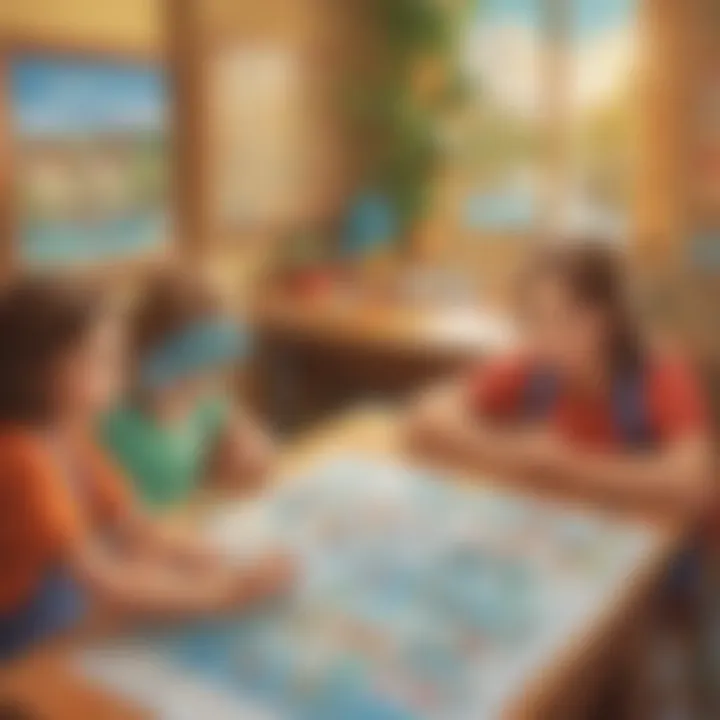Mastering Math Facts: Addition and Subtraction Skills


Intro
Mastering the basics of addition and subtraction is crucial for elementary students. Understanding how to combine and take away numbers up to twenty sets the groundwork for more advanced math skills. This can greatly influence their overall confidence in dealing with numbers and arithmetic.
Engaging children in these fundamental concepts can be done through various methods. This article will cover several effective strategies, such as creative activities, games, quizzes, and systematic practice. Each method fosters a deeper understanding and helps in nurturing a positive attitude towards math.
Creative Activities
Engaging children in hands-on activities can make learning math facts enjoyable and memorable. Creative activities can transform abstract concepts into concrete experiences.
Craft Ideas
Crafts are an excellent way to relate math to daily life. Here are some ideas:
- Number Line Craft: Use a long piece of paper to create a number line. Kids can add or remove items from specific numbers to visualize addition and subtraction.
- Math Fact Flashcards: Let children design their own flashcards. They can draw pictures or use stickers that represent math problems.
Step-by-Step Guides
For the number line craft, follow these steps:
- Gather materials – long paper, markers, scissors, and glue.
- Help children mark numbers from 0 to 20 on the paper.
- Have them place objects at the corresponding positions to represent addition or subtraction.
- Encourage them to write simple problems using the objects for better understanding.
Educational Value
The educational benefits of these activities are significant. They not only reinforce mathematical concepts but also stimulate creativity. Craft activities provide a tangible way to visualize and interact with math facts, leading to better retention and understanding.
Fun Quizzes
Quizzes can be an excellent way to assess understanding while making learning fun.
Quiz Topics
On platforms like ElemFun, quizzes may cover several important topics:
- Basic addition facts (1-20)
- Simple subtraction facts (20-1)
- Word problems that involve addition and subtraction
Question Types
To keep children engaged, quizzes employ various types of questions, such as:
- Multiple choice questions
- Fill-in-the-blank problems
- True or false statements
Knowledge Reinforcement
Quizzes serve as a tool for knowledge reinforcement. They allow students to test their understanding and identify areas needing improvement. Such regular practice leads to a stronger grasp of foundational math skills.
Fact-Based Articles
Reading fact-based articles can enhance children’s numerical skills further.
Topics
The range of topics covered may include:
- Number patterns
- Real-life applications of addition and subtraction
- Fun facts about math history
Engaging Content
Articles introduce these concepts in an engaging and easy-to-understand manner. They explain complex ideas in simple language, ensuring all readers can follow along. It is an approach that invites curiosity and encourages exploration.
Understanding Math Facts
Understanding math facts is crucial for laying the groundwork in elementary mathematics. It creates a framework on which advanced concepts can be built. Mastery of basic addition and subtraction to twenty paves the way for more complex problem-solving and critical thinking skills. This section explores the definition and importance of math facts in education.
Definition of Math Facts
Math facts are simple equations or number combinations that students need to memorize for quick recall. Specifically, addition and subtraction facts up to twenty include calculations like 5 + 3 = 8 or 15 - 6 = 9. These facts become essential building blocks in a child's mathematical arsenal.
Proficient recall of math facts enables students to tackle more complex arithmetic without hesitation. As students become adept, they can handle larger numbers and multi-step problems more easily. Math facts are not just mere calculations; they are fundamental knowledge, allowing students to progress effortlessly through their academic journey.
Importance of Mastery
Mastery of math facts is significant for several reasons:
- Confidence Building: When students can recall these facts effortlessly, their confidence increases in math class.
- Fostering Independence: Quick recall helps students work independently on their math assignments without constant assistance.
- Performance Improvement: Having strong foundational skills leads to better performance in more advanced math topics, such as multiplication, division, and fractions.
Moreover, the benefits extend beyond immediate academic performance.
"Mathematical ability is linked to logical reasoning skills, which are valuable in many aspects of life."
This mastery not only aids in classroom assessments but also equips children with skills necessary for everyday situations—like making change, budgeting, and more.
Therefore, understanding and mastering math facts is not merely an academic exercise; it is an investment in a child's future capabilities and confidence in both academic and real-world contexts.
The Role of Addition and Subtraction
Addition and subtraction are fundamental skills in mathematics. They form the basis for more complex operations and concepts. Understanding these operations is crucial for developing number sense and mathematical fluency. In this section, we will explore the specific roles that addition and subtraction play in early math education and their importance in everyday life.
Understanding Addition
Addition is the process of combining two or more quantities to get a total. It is often one of the first math operations taught to children. The concept is relatively simple, yet powerful. For example, if a child has three apples and is given two more, they can find out how many apples they have in total by adding the two groups together. This basic understanding lays a strong foundation for future arithmetic skills.
In addition, promoting various strategies for learning addition helps to accommodate different learning styles. Children can benefit from using finger counting, counting on from the larger number, or using objects like blocks or beads to visualize the process. All of these methods reinforce the idea of combining quantities. Regular practice in addition also enhances speed and accuracy, which is vital as they progress to multi-digit addition and other math topics.
"Mastering addition is not just about getting the right answer; it is about building confidence in one's ability to handle numbers."
Understanding Subtraction
Subtraction is the process of taking away a quantity from another. While it may appear straightforward, it introduces concepts such as difference and comparison. For instance, if a child has five oranges and eats two, they can subtract the two from five to learn that they now have three. This concept of 'taking away' is essential not only in math but also in understanding real-world scenarios.


Similar to addition, there are various methods to grasp subtraction. One effective approach is the 'taking away' method, where students physically remove items from a group. They can also use the number line to visualize the subtraction process. For instance, starting from five and moving two spaces to the left on a number line effectively illustrates what is happening. Understanding subtraction in terms of finding the difference between numbers is also a valuable skill that enables children to solve more complex problems later on. Moreover, these skills help in everyday situations, such as managing money or measuring distances.
Overall, both addition and subtraction are integral to mathematical understanding. They are not only foundational for future math learning but also essential skills used in everyday life.
Methods for Mastering Addition Facts
Mastering addition facts is crucial for young learners. It lays the foundation for more complex mathematical concepts. Understanding the methods to learn addition can greatly enhance a child's speed and accuracy in basic math. By employing various strategies and tools, children can gain confidence in their abilities. Consequently, this mastery translates into better performance in math-related tasks.
Counting Strategies
Counting strategies are among the simplest ways to teach addition. Using physical objects, children can visually connect numbers with quantity. For instance, counting blocks or beads can help illustrate the concept of addition effectively. When a child adds two groups of items, they physically combine them to see how many they have. This method encourages children to explore addition in a hands-on manner, making learning engaging and tangible.
Incorporating counting strategies can have several benefits:
- Visual Learning: Children can see how numbers come together.
- Tactile Engagement: Touching and moving objects reinforces their learning.
- Foundation Skills: This builds counting skills, which are essential for later math.
Using Number Lines
Number lines offer another effective method for mastering addition. A number line displays numbers in sequential order, allowing children to visually represent addition operations. When a child needs to find the sum of two numbers, they can start at the first number on the line and then move forward the value of the second number. This linear approach simplifies addition, nurturing spatial awareness in young learners.
Using number lines provides unique advantages:
- Clear Visualization: Children see the relationship between numbers.
- Error Reduction: They can check their work by following the line.
- Flexible Use: Number lines can adapt to larger numbers or different math operations.
Flashcards and Drills
Flashcards and drills remain popular tools for practicing addition facts. Flashcards present a quick way for students to learn and memorize sums. They can be used individually or in group settings. The repetitive nature of drills helps reinforce memory retention. When children practice regularly, they begin to recall addition facts almost instantly, which is important for fluency.
The benefits of flashcards and drills include:
- Focused Practice: Targets specific addition problems.
- Quick Assessment: Allows for immediate feedback on performance.
- Fun Variations: Flashcard games can motivate children through interactive learning.
"Regular practice with addition is the key to building a strong mathematical foundation."
By combining these methods, children can engage with addition facts in diverse and effective ways. The goal is to create a solid understanding that will serve them well in higher-level math as they progress in their education.
Techniques for Learning Subtraction Facts
Understanding subtraction is crucial for young learners as it lays the groundwork for more complex mathematical concepts in later years. Techniques for learning subtraction facts serve as essential tools. They help children develop a solid foundation and improve their overall confidence in math. When students master subtraction, they can efficiently tackle problems in real-life contexts, enhancing both their analytical skills and decision-making abilities.
Subtraction, unlike addition, requires a different approach. It often involves breaking down numbers and understanding their relationships. Techniques that focus on these aspects are imperative for learners to grasp subtraction beyond rote memorization. By using distinct strategies, educators and parents can make learning subtraction engaging and effective for learners.
In this section, we will discuss two primary techniques for learning subtraction facts: the Taking Away Method and Finding the Difference. Each method offers unique benefits and suits different learning styles.
Integrating Visual Aids
In the realm of mathematics, especially at an elementary level, visual aids serve a crucial role. They help transform abstract concepts into tangible understanding, which is essential for mastering basic math facts like addition and subtraction up to twenty. Visual aids can clarify relationships between numbers and illustrate what mathematical operations actually mean. This approach caters to various learning styles and can notably enhance retention of material.
One of the major benefits of using visual aids is that they nurture a deeper comprehension. Children often struggle with numbers when they cannot visualize what they represent. When students see numbers as physical entities through manipulatives or models, their grasp of mathematical principles strengthens. It is not simply about performing operations but truly understanding the connections and concepts behind them.
Moreover, when visual aids are utilized, they can increase engagement in learning. Young learners are often more interested when they can interact with visual components. They encourage exploration and experimentation, promoting a more hands-on experience which can lead to better learning outcomes. However, flexibility is vital. Different learners may respond uniquely to varied types of visual aids, so the selecton of tools should reflect this diversity.
Using Manipulatives
Manipulatives are objects that children can use to physically interact with numbers. These can range from simple counting blocks to more complex tools like base ten blocks. When students work with manipulatives, they bridge the gap between concrete experiences and abstract thinking. For instance, when teaching addition, a child can physically combine blocks to see how numbers come together.
This hands-on approach also fosters problem-solving skills. Children often discover multiple ways to reach an answer when they can manipulate numbers at a tactile level. It cultivates curiosity, as they may explore how subtraction works by physically removing blocks from a larger set. With manipulatives, learning becomes an active process instead of a passive one.
Key advantages of manipulatives include:
- Encouraging Active Participation: Children are not just listening; they are doing.
- Fostering Independence: Students can explore solutions on their own.
- Visualizing Concepts: They can literally see the math happening.
Visual Math Models
Visual math models, such as number lines, ten frames, and charts, provide structured ways to represent operations. A number line, for example, can effectively demonstrate both addition and subtraction. When students visualize movement along a number line, it enhances their understanding of how numbers relate to each other. Similarly, a ten frame can aid in conceptualizing basic addition facts by visually displaying groups.
Using visual models in teaching emphasizes relationships among numbers. When children see how addition involves combining numbers to create a larger total, or how subtraction requires understanding how to find what remains, they internalize these ideas more deeply.
For implementation, consider:
- Interactive Displays: Create number lines in the classroom using tape or chalk on the floor.
- Consistent Use of Models: Reinforce concepts consistently with visual aids at every opportunity.
- Encourage Self-Representation: Let students draw their models to reflect their thinking.
By implementing various visual aids, educators can transform the introduction of addition and subtraction into a more enriching experience that promotes lasting skills.
Incorporating Games and Activities
Incorporating games and activities into math education serves as a powerful tool for enhancing the understanding of addition and subtraction. This approach does not merely make learning enjoyable; it transforms study into an engaging experience. Games can capture students' attention and foster a collaborative learning atmosphere. When children play math games, they become active participants rather than passive learners, which can significantly boost their confidence and retention of math facts.
The integration of games allows children to practice addition and subtraction in varied contexts. Some games help reinforce basic skills, while others may present new challenges, introducing concepts in a playful manner. Moreover, using games often encourages interaction among peers, promoting teamwork and communication skills. This social aspect can further motivate students and help them feel more comfortable with their math abilities.
Benefits of Incorporating Games and Activities
- Engagement: Games increase interest and attention, making lessons more dynamic and less monotonous.
- Concept Reinforcement: Repeated practice through games solidifies knowledge without the pressure of formal testing.
- Skill Application: Games often require children to apply what they have learned in real-time, fostering critical thinking.
- Feedback and Adaptation: Many game formats provide instant feedback, allowing learners to recognize areas for improvement.
- Building Confidence: A game-focused environment can create a space where mistakes are part of the learning process, helping to ease the fear of failure.
Ultimately, incorporating games into math helps lay a solid foundation for mastering addition and subtraction.
Board Games for Math
Board games offer tactile enjoyment and social interaction while allowing for the practice of math facts. Games such as Sum Swamp or Math Dice successfully integrate math skills with play. Sum Swamp, for instance, requires players to add and subtract to navigate through a swamp. This game not only reinforces math skills but also develops strategic thinking as players must decide the best way to move.
Here are some notable advantages of using board games for math:
- Interactive Learning: Board games typically require players to engage with each other. This collaboration assists in developing social skills and creates a bond through shared experiences.
- Diverse Skills Practice: Many games encompass various types of problems, ensuring a rounded approach to math practice.
- Measurement of Progress: As students play over time, it becomes evident which concepts are well understood and which require additional focus.
To maximize the benefits of board games, educators and parents can periodically switch the games used to introduce new concepts and maintain engagement.
Online Resources and Apps
The digital landscape provides numerous resources and applications specifically designed for mastering math skills. Websites such as Khan Academy and apps like Zearn provide structured learning paths for children. These platforms use interactive formats and rewards to keep young learners motivated.


Online resources can offer many benefits:
- Accessibility: Children can practice math anytime and anywhere with internet access.
- Personalized Learning: Many programs adapt to the user’s skill level, ensuring that each learner receives appropriate challenges.
- Engaging Content: With the use of animations and interactive tasks, students remain engaged, often wanting to return to these activities.
Apps like Prodigy Math allow children to engage with their peers in a fun, competitive environment. This gamified approach keeps learners invested in improving their skills while also promoting a sense of accomplishment.
Setting Goals and Tracking Progress
Setting goals and tracking progress are essential components in mastering math facts such as addition and subtraction to twenty. These elements provide a clear pathway for learners, ensuring they know what they aim to achieve. When specific, measurable goals are in place, students can focus their efforts on essential skills. Moreover, tracking progress not only motivates students but also provides insights for both educators and parents regarding areas that may require more attention.
Establishing Learning Milestones
Learning milestones are critical as they break down the larger goal of mathematical fluency into smaller, achievable steps. These milestones aid in providing structure to the learning process. For instance, rather than aiming for full mastery of addition and subtraction to twenty right away, a student might set a milestone of mastering all single-digit addition problems first. This step-by-step approach reduces overwhelm, making the learning process more manageable and confidence-building.
Parents and educators can establish these milestones by:
- Identifying Key Skills: Focus on essential addition and subtraction facts that are foundational to more complex mathematical concepts.
- Setting Timeframes: Establish a timeline for achieving each milestone, which helps create a sense of urgency and purpose.
- Providing Positive Reinforcement: Celebrate achievements, no matter how small. This encourages students to remain engaged in their learning journey.
Self-Assessment Techniques
Self-assessment is a valuable technique that empowers students to reflect on their learning. It invites learners to evaluate their understanding and proficiency in addition and subtraction facts. Regular self-assessment can uncover areas where students feel confident and areas requiring further practice.
Several effective self-assessment techniques include:
- Quizzes: Short, timed quizzes can help students gauge their speed and accuracy with math facts. These should focus on various combinations of numbers up to twenty.
- Reflection Journals: Encouraging students to maintain journals where they write about their learning experiences can enhance self-awareness. They can note what concepts they find easy or challenging.
- Peer Evaluation: Collaborating with classmates to teach and quiz each other fosters a supportive learning environment. Peer feedback can offer insights that one might overlook on their own.
"Assessing one's learning progress can illuminate the path forward more clearly."
By incorporating these methods into the learning process, students in elementary schools can enhance their understanding of math facts. Setting precise goals and employing effective tracking through milestones and self-assessments creates an environment that promotes sustained learning and mastery.
The Impact of Regular Practice
Regular practice is crucial when mastering addition and subtraction up to twenty. This consistent effort helps solidify foundational math facts, allowing students to recall them quickly and accurately. Developing fluency in these operations creates a platform for more advanced mathematical concepts later on. When learners engage with math facts repeatedly, they build neural pathways in the brain which aids retention and accessibility.
Repeated exposure not only aids memory but also improves problem-solving skills. By encountering various problems through practice, students learn to recognize patterns and apply learned strategies effectively. This experience can increase their ability to tackle unfamiliar situations in math, boosting their overall confidence.
Building Confidence through Repetition
Repetition fosters familiarity. When children practice addition and subtraction regularly, they become more comfortable with numbers. This comfort translates into confidence. Confident learners are more willing to engage in challenging activities. They express a more positive attitude towards math, leading to a greater willingness to learn.
To support this, educators and parents should encourage practice in a low-pressure environment. This can include self-paced activities and games that integrate math facts into fun scenarios. Positive reinforcement greatly enhances a child’s confidence. By celebrating small victories, children see their progress, which motivates further practice.
"Confidence is key. With each successful calculation, a child builds a more robust mathematical identity."
Creating a Study Schedule
A structured study schedule is a vital component of effective learning. It provides a framework for children to engage with addition and subtraction consistently. When children have a clear plan, they are more likely to practice regularly.
Consider dividing study sessions into short bursts, allowing for focused practice without overwhelming the learner. For example, a daily session could last 15 to 20 minutes. Within this time, include various activities to maintain interest. Mix number games, flashcard drills, and online math resources.
It’s also important to allow flexibility in the schedule. Some days might require more focus on subtraction, while others may center on addition. Here are some tips to create an effective study schedule:
- Set specific days and times for practice each week.
- Rotate different methods to keep the practice engaging.
- Incorporate breaks to avoid fatigue and maintain focus.
- Assess progress regularly to adapt the schedule to the child’s development.
Overall, ensuring learners have an organized study plan emphasizes the value of regular practice. It can help establish a routine that promotes ongoing success in mastering math facts.
Supporting Struggling Learners
In the realm of early mathematics, it is crucial to address the needs of struggling learners. Every child has a unique learning style, and some students may find addition and subtraction to twenty particularly challenging. Recognizing these difficulties early can help educators and parents provide necessary support. When a child struggles with basic math facts, it can lead to frustration and a lack of confidence. Failure to master these foundational skills may result in more significant challenges in later grades. Therefore, targeted support is essential for fostering mathematical competence.
Identifying Common Challenges
Struggling learners often face specific challenges that impede their grasp of basic math facts. Some of these challenges include:
- Memory Retention: Many children have difficulty remembering math facts, especially when they are presented without context or visual aids.
- Anxiety: Math anxiety can arise from past negative experiences. This fear can create a mental block, making it harder for students to engage with math.
- Understanding the Concepts: A lack of understanding of the underlying concepts, such as the relationship between addition and subtraction, can hinder progress.
- Speed Issues: Some students may take longer to process math problems. This can result in lower confidence when compared to peers.
Identifying these challenges is the first step in effectively supporting learners in their math journey.
Tailoring Instructional Strategies
To assist struggling learners, it is important to tailor instructional strategies. These strategies should address the specific challenges identified. Effective methods include:
- Differentiated Instruction: Teachers can provide varied teaching methods that cater to different learning styles. Some students might benefit from hands-on activities while others may prefer visual aids like charts.
- Use of Technology: Incorporating educational software can engage learners in a new way. Programs designed for math practice often offer immediate feedback, which can help improve fluency.
- Small Group Instruction: Working with small groups allows for more personalized attention. This setting can help students feel less intimidated and more willing to ask questions.
- Frequent Assessment: Regular assessments can help educators track progress and identify specific areas needing improvement. This information is crucial for modifying teaching strategies.
Tailoring strategies enhances both engagement and comprehension, creating a supportive environment for struggling learners.
In summary, supporting struggling learners is a vital aspect of teaching addition and subtraction to twenty. Understanding their challenges and implementing tailored strategies can make a significant impact on their mathematical success. By prioritizing these elements, parents and educators can foster a positive approach to math, setting the stage for long-term learning.
Role of Educators and Parents
The participation of educators and parents in the learning process of addition and subtraction is indispensable. Both play vital roles in shaping a child’s attitudes toward math. It is essential that educators employ various techniques in the classroom while parents reinforce these at home. This symbiotic relationship can significantly affect a child’s comfort and confidence with math terms, principles, and practices.
A supportive learning environment lays the foundation for math competency. Both educators and parents have the responsibility to create spaces where children feel safe to make mistakes and ask questions. Children who see adults engaged in math as a positive endeavor are more likely to approach math with enthusiasm.
Facilitating a Positive Learning Environment
Facilitating a positive learning environment is core to the educational philosophy of nurturing young minds. Educators can initiate this by utilizing interactive activities in their teaching methods. This could mean using tools like manipulatives or engaging group exercises that foster cooperative learning.
Parents can support this by promoting math in everyday situations. Using common examples from shopping or cooking might seem trivial, but these moments are learning opportunities. Here are some strategies:
- Create a comfortable space for homework that is free of distractions.
- Encourage group study sessions that allow peer learning.
- Provide varied resources, such as visual aids and hands-on tools, to aid understanding.
These actions lead to a learning atmosphere where children feel valued and motivated to explore math concepts more deeply.
Encouraging a Growth Mindset
Encouraging a growth mindset is critical for overcoming obstacles and fostering resilience among young learners. Educators should highlight the concept that learning is a process, and mistakes are not failures, but stepping stones to mastery. This can be achieved through:
- Providing consistent feedback on effort and improvement rather than just correct answers.
- Sharing stories of how mathematicians or peers struggled before succeeding, thereby normalizing challenges.


For parents, reinforcing this mindset can occur during homework sessions. When they focus on progress and perseverance instead of perfection, children grasp that their capability can grow with practice.
- Celebrate small achievements to encourage the child’s love for learning.
- Stay patient and acknowledge their efforts, which helps create a safe space for learning.
"Mistakes are proof that you are trying."
By creating a supportive and constructive dialogue around challenges in math, both educators and parents can cultivate an environment where children are open to learning, thus fostering a positive outlook towards mathematics.
Utilizing Technology in Math Learning
In today's digital age, technology plays a crucial role in education, especially in subjects like mathematics. The incorporation of technology in learning addition and subtraction can enhance engagement, provide personalized feedback, and allow students to learn at their own pace. Utilizing gadgets and online resources allows students to not only grasp fundamental concepts but also encourages a more interactive learning experience. Here are key points to consider regarding the integration of technology in mastering math facts.
Educational Software and Tools
Educational software provides diverse methods for teaching math facts. Programs such as DreamBox and IXL Math adapt to the learner’s pace, providing tailored exercises that suit their needs. These platforms often feature interactive tutorials and engaging visuals. Different types of software can target various skills, whether it be basic addition and subtraction or more complex concepts.
- Adaptability: Software adjusts to the user's level, ensuring appropriate challenges.
- Feedback: Immediate feedback is integral for understanding mistakes and correcting them.
- Game-Based Learning: Many programs incorporate games that make practice enjoyable and less daunting.
Using these tools effectively requires consideration of screen time and balance with traditional methods of learning.
Interactive Learning Platforms
Interactive learning platforms are particularly valuable in mastering addition and subtraction. Websites such as Khan Academy and ABCmouse present math facts in an engaging format. These platforms often feature videos, practice problems, and progress tracking, which support independent learning while offering a structured path.
- Engagement: Using multimedia helps maintain student interest and focus.
- Variety: Exposure to multiple teaching methods caters to different learning styles.
- Progress Monitoring: Many interactive platforms provide insights into a student's progress, allowing parents and educators to identify areas of strength and improvement.
Ultimately, both educational software and interactive learning platforms enrich the math learning experience, making it both accessible and enjoyable for students. Incorporating these technologies in a structured manner enables a comprehensive approach to mastering fundamental math skills.
"Technology is not just a tool. It can give learners a voice that they may not have had before." - George Couros
Measuring Mathematical Fluency
Measuring mathematical fluency is an essential component in the journey of mastering addition and subtraction up to twenty. Fluency here refers to the ability to perform these operations with speed and accuracy while maintaining a clear understanding of the concepts behind them. Children who develop fluency can solve problems quickly and confidently, which prepares them for more complex mathematical tasks in the future.
Understanding mathematical fluency involves assessing not only how quickly a child can perform calculations but also their level of accuracy. This dual focus helps identify areas where students may need additional support or practice. The benefits of measuring fluency include:
- Identification of Strengths and Weaknesses: Teachers and parents can pinpoint which math facts a child has mastered and which ones require further attention.
- Boosting Self-Confidence: Children who see improvement in their speed and accuracy are likely to feel more confident in their math abilities.
- Foundation for Future Learning: A solid understanding of basic math facts sets the groundwork for more advanced concepts in mathematics.
Considering these elements highlights the importance of tracking progress in mathematical fluency. Accurate measurement allows for strategic interventions, ensuring that children do not fall behind.
Assessing Speed and Accuracy
Assessing speed and accuracy entails to give children timed tests on addition and subtraction facts. This practice is straightforward and can help in gathering vital data about a child’s capabilities. Timed tests can be conducted using worksheets or digital platforms that provide immediate feedback.
Key elements to consider in assessments include:
- Setting Realistic Goals: Goals should be achievable yet challenging to motivate children.
- Regular Practice: Frequent assessments help students understand their progress over time.
- Adaptation of Methods: Adapting to each child's unique learning style can enhance the assessment process.
Using tools like charts to track progress visually can aid children in understanding how close they are to achieving fluency.
Standardized Testing Insights
Standardized testing offers a structured way to evaluate a child's understanding of math facts in a broader educational context. These tests often include sections on basic addition and subtraction, allowing educators to compare a child's performance against national benchmarks. Understanding a child's score on these tests can provide insights into relevant instructional adjustments.
It's important to consider how standardized tests:
- Guide Educational Focus: Schools may tailor their curricula based on common outcomes in these assessments.
- Highlight Achievement Gaps: Results show where children excel and where additional emphasis may be needed, informing teaching strategies.
- Assist in Placement Decisions: Results often influence recommendations for advanced classes or interventions if necessary.
Children should be prepared for standardized tests through regular, effective practice of math facts. Familiarity with the test format can also alleviate any anxiety associated with testing. In summary, measuring mathematical fluency encompasses diverse methods, all of which reinforce the core goal of enhancing children's mathematical skills and confidence.
Encouraging Lifelong Math Skills
Encouraging lifelong math skills is crucial for helping children build a solid foundation in mathematics that they can carry into adulthood. Understanding basic math facts like addition and subtraction lays a groundwork that not only supports further learning but also enhances everyday decision-making. Children equipped with these skills can manage personal finances, assess measurements in daily tasks, and engage more critically with real-world problems.
Connecting Math to Everyday Life
Connecting math to everyday life gives context to abstract concepts. When children see how math applies to their daily routines, it fosters a sense of relevance. For example, calculating discounts while shopping or sharing a pizza among friends are practical applications of addition and subtraction. Such situations highlight the importance of math in mundane activities. Parents and educators can encourage this connection by involving children in activities where they can apply math.
- Grocery Shopping: When children go shopping with parents, they can help to add prices or figure out how much to save for a needed item.
- Cooking: In the kitchen, they can measure ingredients, which incorporates both addition and subtraction when adjusting recipes.
- Games: Playing board games that require counting or calculating can also provide fun ways to see math in action.
This practical application nurtures a mindset that recognizes math as an essential tool in life. It can lead to greater interest and less anxiety about math-related tasks.
Nurturing a Love for Mathematics
Nurturing a love for mathematics takes intentional effort from both parents and educators. Children often develop feelings about subjects based on experiences. Positive reinforcement, encouragement, and exposure to math-related activities can cultivate a genuine interest.
One way to nurture this love is to introduce children to engaging math games and educational puzzles. Through these activities, children not only learn but do so in a pleasant environment, reducing the stress often associated with learning math. It can also help them see the joy in problem-solving.
- Interactive Learning: Use resources like educational apps or websites that make learning fun.
- Peer Collaboration: Group activities or math clubs with peers can lead to cooperative learning experiences, fostering social skills along with math proficiency.
Furthermore, modeling enthusiasm for math as adults makes a significant impact. When children see their parents and teachers actively valuing math, they are more likely to develop a similar appreciation.
"Mathematics is not about numbers, equations, or algorithms; it is about understanding."
Summary of Key Takeaways
Understanding the key takeaways from mastering addition and subtraction facts is crucial for educators, parents, and students. This section emphasizes the effectiveness of various learning strategies and the long-term benefits of achieving proficiency in these fundamental math operations.
The mastery of addition and subtraction to twenty serves as a cornerstone for more advanced mathematical concepts. As children progress in their education, the ability to quickly and accurately perform basic operations lays the groundwork for tackling more complex problems in arithmetic and beyond. By focusing on aspects such as visualization, regular practice, and engaging methods, this article highlights how different strategies contribute to successful learning outcomes.
Recap of Learning Strategies
The strategies discussed throughout the article encompass a wide range of approaches aimed at enhancing mathematical proficiency. Some of the most effective ones include:
- Counting Strategies: Building a number sense through counting objects or even fingers to aid in visualization. This method encourages children to see numbers in a tangible context.
- Using Number Lines: The number line acts as a visual tool, useful for both addition and subtraction, helping children understand the operations and recognize patterns.
- Flashcards and Drills: Repeated practice through flashcards can foster memorization and help students develop speed and accuracy through drills.
- Games and Activities: Engaging methods such as board games or online resources make learning fun and interactive, which aids in retaining information.
These strategies should be adapted based on individual student needs. Ensuring variety will maintain interest and encourage continuous improvement.
Final Thoughts on Math Mastery
Achieving mastery of math facts is not just about rote learning; it is about developing a genuine understanding and comfort with numbers. Students who master addition and subtraction to twenty gain confidence as they progress to more complex mathematical tasks. The key is to cultivate a positive learning experience.
Encouraging curiosity and a willingness to explore math can have profound long-term effects. Also, helping students relate math concepts to real-life situations can make the subject more relevant and appealing.
"Proficiency in foundational math facts opens doors for continual learning in mathematics, paving the way for future academic success."







